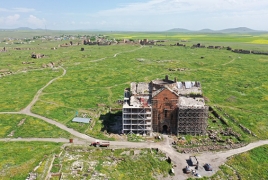
The Turkish state-run Anadolu Agency reports that restoration work is underway at the historic Ani Cathedral, part of the ancient city of Ani. The “reconstruction project” is being implemented in three phases through a partnership between Turkey’s Ministry of Culture and Tourism and the World Monuments Fund. Upon completion, the cathedral is expected to reopen as a mosque, making it accessible to visitors, according to Factor.am .
The Ani archaeological site was added to UNESCO’s Tentative World Heritage List in 2012 and was officially registered as a Cultural Heritage site in 2016.
The report notes that the roughly 100-hectare Ani site includes several structures attributed to the Turkish-Islamic historical period. Among them are the Ebü’l Menüçehr Mosque (Ani’s Great Mosque), considered the first Turkish mosque built in Anatolia, a Seljuk cemetery and mausoleums, as well as several Christian monuments—including the Cathedral of Ani (referred to as Fethiye Mosque), the Church of the Redeemer, the Church of Tigran Honents, and the Church of Abughamrents.
Notably, there is no mention of Ani’s Armenian origins or the Armenian identity of these churches. The cathedral is referred to only as the Fethiye Mosque. According to the same source, the cathedral’s construction began under King Smbat II in 987 and was completed in 1010 by Queen Katramide, wife of King Gagik I. However, the report omits the fact that both were Armenian monarchs.
The cathedral’s architect, Trdat—who later repaired the dome of Hagia Sophia in Constantinople—is also mentioned without noting his Armenian heritage.
Historically, the Armenian cathedral was converted into a mosque in 1064 by Seljuk Sultan Alp Arslan. It was named the “Fethiye Mosque” because Alp Arslan performed his first Friday prayer there.

